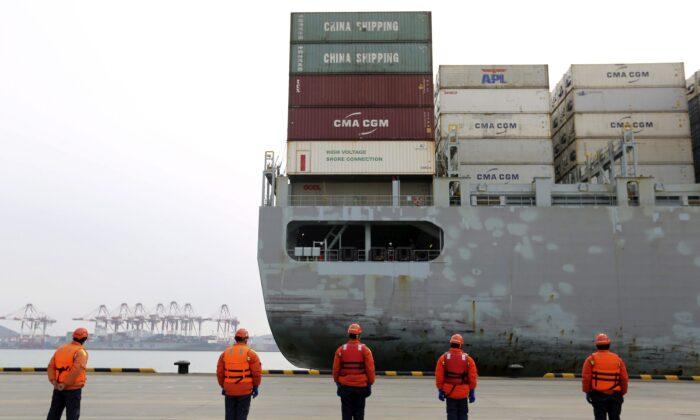WASHINGTON—A pandemic wasn’t on the radar when the United States and China inked “phase one” of a trade agreement in mid-January.
And only a few months into the trade deal, mounting accusations against China for mishandling the virus outbreak and failing to fulfill its purchase targets in the agreement have revived fears of a second trade war between Washington and Beijing.
The phase one pact, which went into effect on Feb. 14, requires China to buy $200 billion worth of additional U.S. goods and services over the next two years.
Trade data for the first quarter, however, indicates that Beijing is falling short on its promises and even running behind 2017 values.
“When the deal was signed in January, no one thought China would be able to make the purchasing commitments then,” Riley Walters, senior policy analyst and economist at The Heritage Foundation, told The Epoch Times.
And with the pandemic, the likelihood of the purchasing agreement being met is even lower, he added.
However, some leeway exists in the agreement because there’s no real metric to measure China’s progress toward meeting its purchase commitments.
“There’s no month-to-month quota that they have to meet. The phase one deal lines out purchasing requirements on a year-end basis with the goal being the end of two years.”
In addition, the deal text contains a clause that allows for a delay of compliance due to a “natural disaster or other unforeseeable event.”
According to Walters, China has to increase purchases of nearly 540 goods specified in the phase one deal, which include certain manufactured goods, farm, and energy products.
China is supposed to purchase $142.6 billion worth of these goods in 2020 alone, he noted. And based on his analysis, China has only been able to import $14 billion worth of U.S. goods in the first quarter of this year.
In order to satisfy the deal, Beijing has to accelerate its purchases sharply in the remaining nine months.
Walters believes that China will not be able to make it unless there’s a huge uptick.
And if President Donald Trump chooses to impose new tariffs, “the phase one deal with China would probably be thrown out the window at that point.”

‘Ultimate Punishment’
The Trump administration has recently adopted a more hawkish tone with respect to China’s initial handling of the coronavirus outbreak. And some believe Trump may take action against Beijing before the election amid mounting calls from Republicans to hold China accountable.Trump said he would consider new tariffs on Chinese goods to get back at Beijing.
“Well, it’s the ultimate punishment,” he said on May 3 at a virtual town hall meeting on Fox News. He declined to provide details about his retaliatory plans other than tariffs.
“I don’t like to tell,” he said. “Because, you know, we’re all playing a very complicated game of chess or poker.”
Trump also said he will “terminate” the phase-one deal if Beijing fails to fulfill its promises.
“Now they have to buy, and if they don’t buy, we’ll terminate the deal. Very simple,” he said.
The next day, Treasury Secretary Steven Mnuchin warned Beijing of “very significant consequences” for not honoring the trade deal.
“I have every reason to expect that they honor this agreement. And if they don’t, there would be very significant consequences in the relationship and in the global economy as to how people would do business with them,” Mnuchin told Fox News.
A potential reemergence of trade frictions is creating “numerous uncertainties” for businesses, according to Matthew Luzzetti, chief U.S. economist at Deutsche Bank. He believes Beijing will fail to fulfill its promises.
Farm Purchases
U.S. agriculture has been the centerpiece of the phase one trade agreement as farmers were among the hardest hit in the tariff dispute with China. Since 2009, China has been the United States’ top agricultural export market outside of North America.Trump touted the deal in 2019, saying “there’s never been a deal of this magnitude for the American farmer.” He suggested farmers “buy more land and get bigger tractors.”

Through March 2020, China’s agricultural purchases from the United States stood at $5.08 billion, short of the 2017 value of $9.09 billion, he told The Epoch Times.
The agreement requires China to increase its purchases by $12.5 billion this year and by $19.5 billion in 2021 from the 2017 baseline level of nearly $24 billion.
Grant believes these farm purchase targets aren’t ambitious.
“Think about the soybean market in China. China imports $35 billion to $38 billion worth of soybeans a year,” he said. “One commodity can account for half of the additional increase stipulated by the phase-one deal.”
However, he notes that there is a seasonal element in farm exports.
“The bulk of our normal agricultural trade flows occurs in the fall period from September to December,” he said.
“I think you will see the bulk of the shipments come in in the third and fourth quarters, and that'll be the real test.”
The U.S. Department of Agriculture and the Office of the U.S. Trade Representative didn’t respond to requests for comment about China’s progress toward meeting its phase one purchase commitments.





